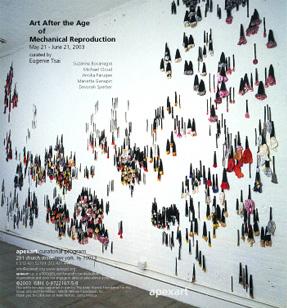Suzanne Bocanegra
Marietta Ganapin
Devorah Sperber
Anoka Faruqee
Michael Cloud
Eugenie Tsai
20/5/2003
Art After the Age of Mechanical Reproduction
Apexart, New York
The artists devise systems to break the image down into modules and employ labor-intensive techniques to reconstruct the modular image, transforming the source material in the process. Although they are aware of developments in computer technology, and the ability to scan and fragment images into pixels, their art reveals a commitment to making unique works by hand, using time-consuming repetitive processes. The work of five artists; curated by Eugenie Tsai

Curated by Eugenie Tsai, Independent Curator, New York
Art in the Age of Mechanical Reproduction features the work of five artists who reproduce paintings, often, but not always, from photographic reproductions. The artists devise systems to break the image down into modules and employ labor-intensive techniques to reconstruct the modular image, transforming the source material in the process. Although they are aware of developments in computer technology, and the ability to scan and fragment images into pixels, their art reveals a commitment to making unique works by hand, using time-consuming repetitive processes.
Suzanne Bocanegra's Wall Drawing (After Jan Brueghel), 2002, is based on a reproduction of a painting of a garden that represents the sense of smell. Bocanegra counts the number of petals visible in the reproduction, cuts them out of hand-colored paper, and pins them to the wall so that their placement corresponds to that in the reproduction. Michael Cloud uses algorithms to determine the placement of colors and the disposition of space in his painted copies of Old Master still-lives. He is interested in algorithms because they are logical and vital to communicating instructions to computers, and provide a way to investigate how computers and programming affect our perception of the world. Anoka Faruqee makes "twins" of her painstakingly rendered, richly colored pattern paintings. Some consist of small asterisk-shaped marks on a gridded surface, while others are more organic abstractions. The coordinates of the grid enable Faruquee to replicate the original with subtle, nearly indistinguishable differences that set twins, even identical twins, apart. Devorah Sperber's After Chuck Close..., 2002-03, comprises several panels in diminishing sizes, each reproducing a detail of Close's Self Portrait. In each panel, colorful chenille stems recreate cellular units, large and small, employed by Close to construct his Self Portrait. From up close the images dissolve into abstract patterns created by the accumulation of chenille stems. Marietta Ganapin creates collages from reproductions of works of art found in brochures offered to the public at museum exhibitions. Using a paper punch, she takes apart multiple copies of a single image, reassembling the resulting dots of color and selected details into a mandala. The titles, "found" colors and details cue the viewer into the identity of the work of art used as source material.
A color brochure containing an essay by the curator will be available free of charge. Please contact apexart for further information. Gallery hours are Tuesday to Saturday, 11-6.
Curated by Eugenie Tsai, Independent Curator, New York
apexart curatorial and residency program 291 Church Street New York City 10013
Opening Reception: Wednesday, May 21, 6-8 pm
Curator's talk: Saturday, May 24, 2 pm



